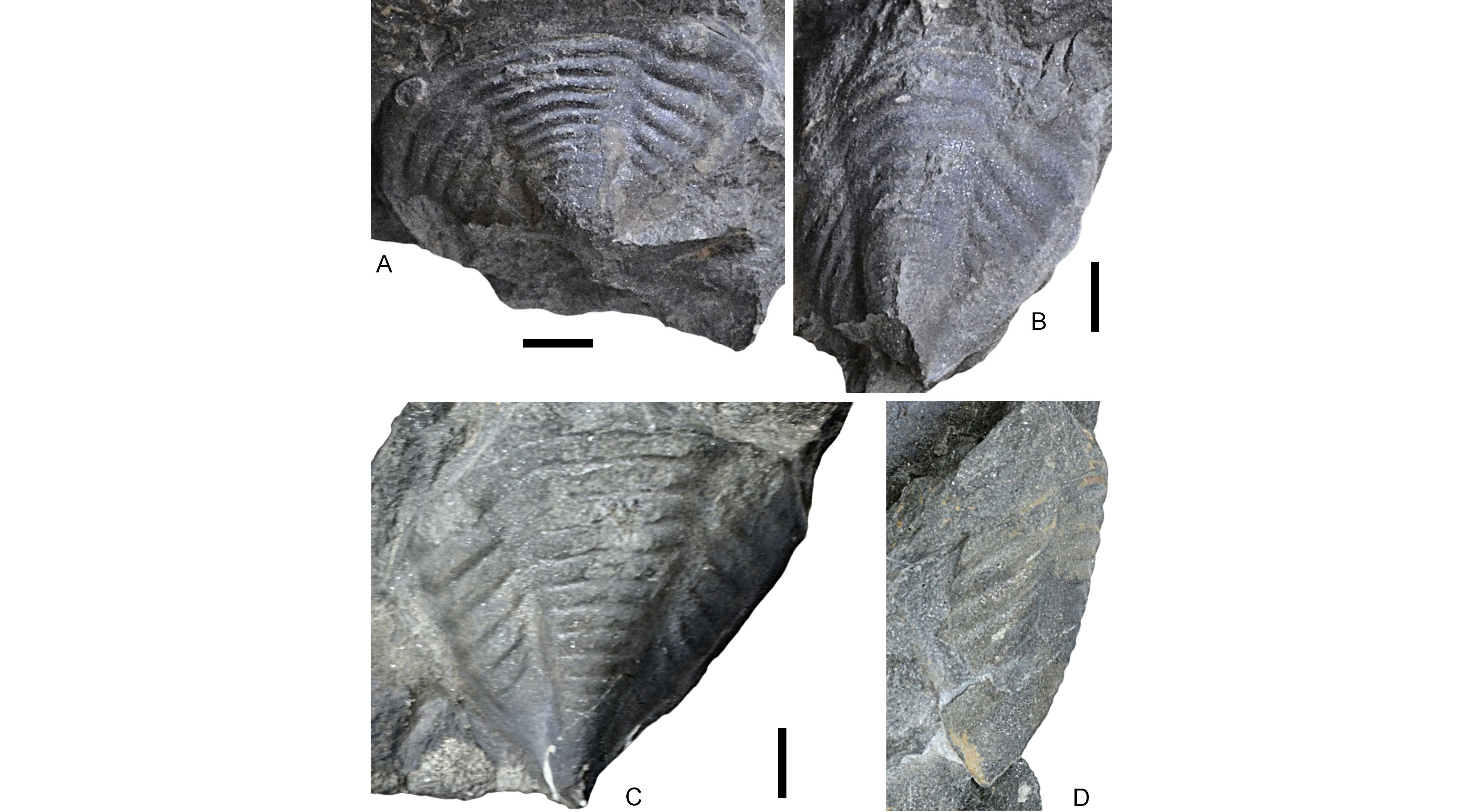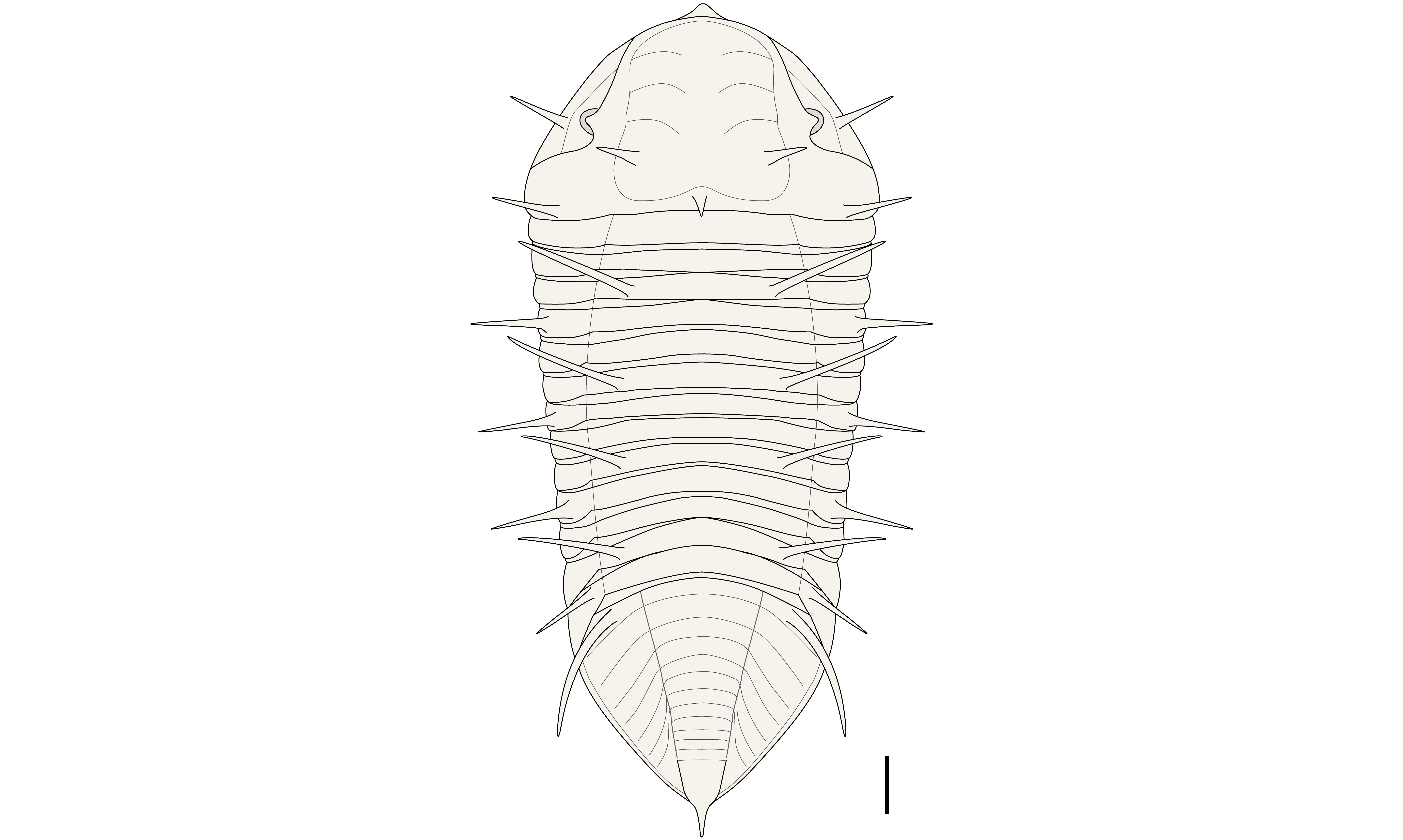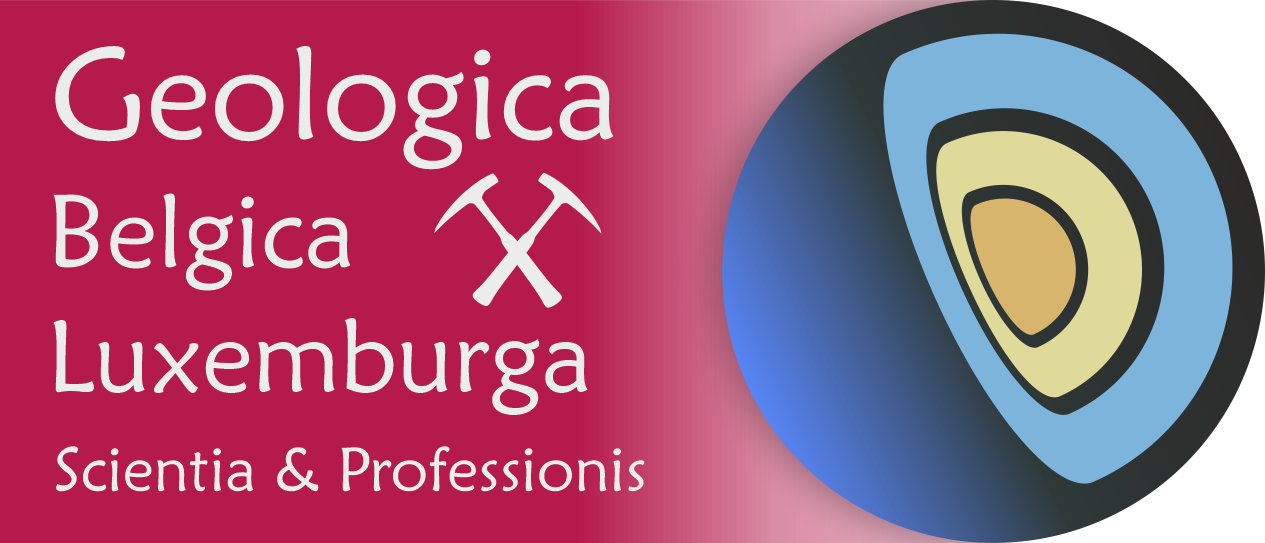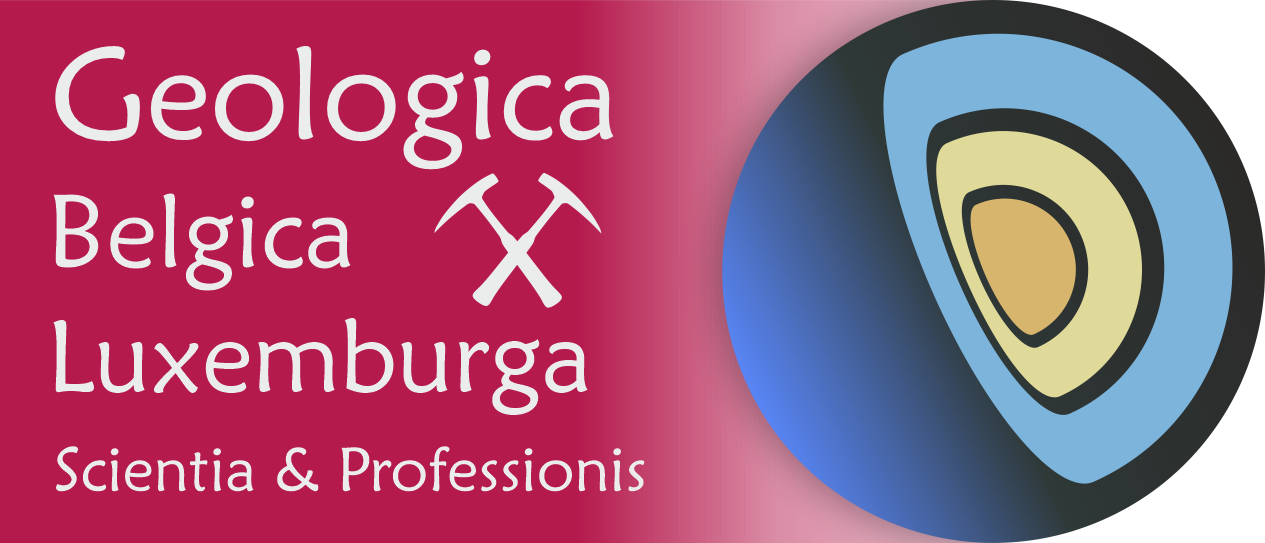- Startpagina tijdschrift
- Volume 28 (2025)
- number 1-2
- New records of the homalonotid trilobite Burmeisterella delattrei (Pillet & Waterlot, 1983) from the Lower Devonian in Belgium and Luxemburg
Weergave(s): 615 (18 ULiège)
Download(s): 378 (5 ULiège)
New records of the homalonotid trilobite Burmeisterella delattrei (Pillet & Waterlot, 1983) from the Lower Devonian in Belgium and Luxemburg

Abstract
The homalonotid trilobite Burmeisterella delattrei is recorded from the early Emsian Ruisseau de la Forge Formation in Belgium (southern limb of the Dinant Synclinorium), somewhat lower than its previously recorded first occurrence in the overlying Vireux Formation. The species may be considered an index fossil for the German Singhofen and Vallendar groups along with the homalonotids Burmeisterella armata and Digonus ornatus ornatus. A pygidium of B. delattrei from the Clervaux Formation in Luxemburg with one of the dorsal spines in place on the first pleural rib, allows a minor modification of current reconstructions of the dorsal exoskeleton to be proposed. The holotype and two paratypes (pygidia) of B. delattrei from the Vireux Formation in northern France are refigured. In total, four species of Burmeisterella, namely B. aculeata, B. armata, B. delattrei (= B. vixarmata) and B. quadrispinosa, are now recognised in the upper Pragian to lower Emsian of Belgium.
Inhoudstafel
1. Introduction
1Homalonotid trilobites are standard elements of the eurhenotypic subfacies (sensu Jansen, 2016) and have long held worthwhile potential as index fossils for the marine Lower Devonian of the Ardennes and neighbouring areas. With a modern taxonomic revision of Devonian trilobites from Belgium well underway (Magrean & van Viersen, 2005) so has their merit to biostratigraphic studies increased. In their provisional synopsis of regional mid-Pragian to Emsian trilobite biostratigraphy, van Viersen & Taghon (2020) considered the homalonotid Burmeisterella delattrei (Pillet & Waterlot, 1983) to range from the Vireux to Clervaux formations. A rock slab containing a monospecific assemblage of B. delattrei sclerites is documented here which was collected south of Couvin, Belgium (Fig. 1) from the upper Pesche Member of the Ruisseau de la Forge Formation, underlying the Vireux Formation (Fig. 2) (see Denayer & Mottequin, 2024 for revision of the former Pesche Formation). This is the stratigraphically lowest record of B. delattrei to date and it is also the second from Belgium. A further pygidium collected from the Clervaux Formation near Wiltz, Luxemburg (Fig. 1) is unique in that it shows the spine on the first pleural rib to be gently coiled in a posterodorsal direction, differing in this respect from published descriptions of this species. The present note serves to document both specimens, to propose a possible alternative reconstruction of the spiny dorsal exoskeleton, and to review biostratigraphic implications.

Figure 1. Schematic geological map (redrawn from van Viersen & Taghon, 2020) of the Ardennes and Eifel regions indicating places mentioned in this paper.

Figure 2. Pragian to Emsian lithostratigraphic units in the Ardenno-Rhenish Massif (adapted from Denayer & Mottequin, 2024 and Jansen, 2016) with projected homalonotid biozones (after Wenndorf, 1990; van Viersen & Taghon, 2020; van Viersen & Müller, 2024). Numbering: 1, Series; 2, Stage; 3, Substage.
2. Localities
2Loc064c, south-southeast of Couvin. Devonian strata exposed during construction works of the new contournement de Couvin (route E420/N5) in 2014 yielded a single rock slab with disarticulated sclerites of Burmeisterella delattrei. The specimen was recovered from brownish siltstones that belong to the Pesche Member of the Ruisseau de la Forge Formation. This Belgian site is located on the southern limb of the Dinant Synclinorium (coordinates are 50°02’07.5”N 4°30’11.6”E). As a result of the infrastructural renovations the new rue de la Platinerie, which affords access to the E420, now conceals the outcrop. However, the highly fossiliferous siltstones of the Pesche Member can be followed west-southwest, on the northern bank of the Eau Noire river between Couvin and Pesche, where they yield locally amassed sclerites of the homalonotid Digonus ornatus ornatus (Koch, 1880) with rare co-occurrences of the acastid trilobite Acastava sp. This area was already known in the late 19th to early 20th centuries for its fossil-bearing outcrops (e.g. Malaise, 1879; Maillieux, 1910, 1912; Asselberghs & Maillieux, 1938). Maillieux (1910) reported Homalonotus planus Sandberger (= Wenndorfia plana (Koch, 1880)) and H. rhenanus Koch, 1880 (= D. ornatus ornatus) from the Pesche Member south of Pesche, at locality Couvin 8697 (= locality 13. – au Fond-de-l’Eau de Pesche of Malaise, 1879). Fossils from the Grauwacke de Pesche at Couvin 8697 and other localities, with hand-written labels from E. Maillieux, are kept by the Institut royal des Sciences naturelles de Belgique (IRSNB). A quick scrutiny of the trilobite specimens led me to identify D. ornatus ornatus, Burmeisterella sp. and Wenndorfia sp. Outcropping siltstones of the Pesche Member just east-northeast from Loc064c, now covered by foundations of the E420, were also sampled in 2014. These yielded a rich macrofauna including mainly brachiopods and a few homalonotid remains (D. ornatus ornatus).
3Merkholtz nordwest quarry (Wiltz). The fossil content of the Clervaux Formation in the Merkholtz nordwest quarry in Wiltz (Éislek, northern Luxemburg) was described by Franke (2006). Specimens of Burmeisterella delattrei from Merkholtz were described as Burmeisterella vixarmata Wenndorf, 1990 and figured by Franke (2006), Alberti & Müller (2008), Müller & Alberti (2010) and Alberti (2015).
3. Biostratigraphy of Burmeisterella species
4According to Müller & Alberti (2010), the sparsely spined Burmeisterella vixarmata had been reported with certainty only in a comparatively small area in northern Luxemburg, western Germany and eastern Belgium between Wiltz, Burg-Reuland and the Ourtal (Fig. 1) where it is restricted to the Klerf Formation (or Clervaux Formation; see comments by Franke, 2006 and Dejonghe et al., 2017 for definition and distinction from the Klerf Formation in the German sense that is not used here). Müller & Alberti (2010) hypothesised that B. vixarmata arose from the slightly older, morphologically similar, yet generally spinier Burmeisterella armata (Burmeister, 1843) through geographic isolation.
5The identity of B. vixarmata and the age of the Burg-Reuland occurrence require examination in order to resolve its true geographic and stratigraphic distributions. According to Müller & Alberti (2010), B. vixarmata is characterised by shallow lateral glabellar furrows and only single spines on the L1 lateral glabellar lobes and on the first pygidial pleural rib pair. Van Viersen & Taghon (2020) pointed out that these same characters are shown by the types of B. delattrei from the Vireux Formation in Vireux, northern France (Fig. 1) and consequently, that these two species are synonyms. The Burg-Reuland locality was placed in the Our Formation which underlies the Clervaux Formation in the area (e.g. Dejonghe et al., 2017). Van Viersen & Taghon (2020) suggested that either all these intervals should be correlated or that B. delattrei has a longer stratigraphic range than previously assumed. Indeed, the new material from the Pesche Member of the Ruisseau de la Forge Formation in Couvin brings to light an even earlier first occurrence of B. delattrei which is, in fact, roughly contemporaneous with the oldest B. armata specimens from the Singhofen Group in Germany (Wenndorf, 1990). This is not inconsistent with records of the much commoner D. ornatus ornatus in the Pesche Member of the Ruisseau de la Forge Formation south of Couvin, the first appearance of the subspecies being in the Singhofen Group in Germany (Wenndorf, 1990). Digonus ornatus ornatus has furthermore been reported from the Our Formation in Burg-Reuland and it is an abundant trilobite in the grès blancs de Mormont (Vireux Formation) in the Mormont area, Belgium (Fig. 1) where it co-occurs with B. armata (van Viersen & Taghon, 2020). According to the present state of knowledge, all three species range through an interval roughly equivalent to the Singhofen and Vallendar groups (Fig 2).
6A third Burmeisterella species, B. quadrispinosa Wenndorf, 1990, occurs in this same interval but its stratigraphically earliest records come from near the base of the Emsian in Germany (Wenndorf, 1990), Belgium (van Viersen & Taghon, 2020) and Luxemburg (van Viersen & Müller, 2024), extending into the Ulmen Group (Fig. 2).
7A fourth species, Burmeisterella aculeata (Koch, 1880), is widely distributed in the Rhenish Mountains in the Middle Siegen and Upper Siegen groups (middle to upper Pragian). Wenndorf (1990) made note of multiple reported occurrences in Belgium citing the works of E. Maillieux and E. Asselberghs, but in the absence of specimen registration numbers or illustrations he could not substantiate these. One such claimed B. aculeata record (Asselberghs, 1923) originates from the Our Formation in Breitfeld, just north of Burg-Reuland, and has been revised as B. quadrispinosa (van Viersen & Taghon, 2020). I have examined homalonotid trilobites in the Asselberghs collections of the Geo-Instituut and Atrecht College of the Katholieke Universiteit Leuven, and concluded that none belong to B. aculeata. In the old Maillieux collections of the IRSNB I traced several exoskeletal remains of this species collected in August 1930 (bearing number I.G. 9383) which come from the Pragian La Roche Formation in La Roche-en-Ardenne (Fig. 3); their revision is underway. To date, these specimens present the only confirmed evidence of B. aculeata from Belgium.

Figure 3. Burmeisterella aculeata (Koch, 1880), La Roche Formation, La Roche-en-Ardenne, Belgium. Internal mould of a thoracopygon (IRSNB a14142). Specimen was untreated prior to photography. Scale bar is 1 cm.
4. Material and methods
8The material is housed in the Muséum des Sciences naturelles d’Angers (prefix MHNAn), the Institut royal des Sciences naturelles de Belgique (prefix IRSNB) and the Musée national d’histoire naturelle, Luxembourg (prefix MnhnL).
9Specimens were treated with ammonium chloride sublimate prior to photography unless stated otherwise.
5. Systematic palaeontology
10Family Homalonotidae Chapman, 1890
11Subfamily Homalonotinae Chapman, 1890
12Genus Burmeisterella Reed, 1918
13Type species. Burmeisterella neoelongata Basse, 2007, nomen novem, pro Homalonotus (Burmeisteria) elongatus Salter, 1865 non Homalonotus elongatus d’Eichwald, 1860, from the Emsian of England.
14Burmeisterella delattrei (Pillet & Waterlot, 1983)
15(Figs 4–6)
16* 1983 Burmeisteria (Digonus?) delattrei Pillet & Waterlot, p. 183–185, pl. 4, figs 1–16.
17* 1990 Burmeisterella vixarmata Wenndorf, p. 129, 130, pl. 1, figs 13–15.
182004 Burmeisterella vixarmata Wenndorf; Müller in Basse & Müller, p. 88, pl. 33, figs 421–425.
192006 Burmeisterella vixarmata Wenndorf; Franke, pl. 18, fig. 3.
202008 Burmeisterella vixarmata Wenndorf; Alberti & Müller, p. 235–237, unnumb. figs.
212010 Burmeisterella vixarmata Wenndorf; Müller & Alberti, p. 64–68, fig. 1, pls 1–3.
222015 Burmeisterella vixarmata Wenndorf; Alberti, figs 9–11.
232020 B. delattrei; van Viersen & Taghon, p. 23.
242024 Burmeisterella delattrei Pillet & Waterlot; Bonino & Kier, p. 370, 372, unnumb. figs.
25Material. Holotype internal mould of a pygidium MHNAn 1999.121 (Fig. 5C, D) and two paratype internal moulds of pygidia MHNAn 2020.0.1941 (Fig. 5A, B) from the Vireux Formation in the Grande carrière du Mont de Vireux (see Pillet & Waterlot, 1983) in Vireux, France; a rock slab (counterpart moulds) with disarticulated sclerites IRSNB a14107 (Fig. 4A, B) from the Ruisseau de la Forge Formation in Couvin, Belgium; an internal mould of a pygidium MnhnL EiB754 (Fig. 4C–G) from the Clervaux Formation in Wiltz, Luxemburg.
26Description. See Pillet & Waterlot (1983) and Wenndorf (1990).

Figure 4. Burmeisterella delattrei (Pillet & Waterlot, 1983). A–B. Counterpart moulds of rock slab containing sclerites (IRSNB a14107), Pesche Member of the Ruisseau de la Forge Formation, south of Couvin, Belgium. C–G. Internal mould of a pygidium with detached thoracic segment (MnhnL EiB754) in dorsal (C), posterior (D), posterolateral (E), lateral (F) and oblique lateral (G) views, Clervaux Formation, Merkholtz nordwest quarry near Wiltz, Luxemburg. White and black arrows in Fig. 4C indicate thoracic segment and spine, respectively. Scale bars are 1 cm.

Figure 5. Burmeisterella delattrei (Pillet & Waterlot, 1983), Vireux Formation, Vireux, France. A. Paratype, internal mould of a pygidium (MHNAn 2020.0.1941) in dorsal view (original of Pillet & Waterlot, 1983, pl. 4, fig. 6). B. Paratype, internal mould of a pygidium (MHNAn 2020.0.1941) in dorsal view (original of Pillet & Waterlot, 1983, pl. 4, fig. 4). C–D. Holotype, internal mould of a pygidium (MHNAn 1999.121) in dorsal and lateral views (original of Pillet & Waterlot, 1983, pl. 4, figs 1–3). Specimens were untreated prior to photography. Scale bars are 1 cm.
27Remarks. Specimen IRSNB a14107 (Fig. 4A, B) contains four incomplete pygidia, several thoracic remains and a partial glabella. Despite their fragmentary preservation, the pygidia reveal single spines on the anteriormost pygidial pleural rib. No spines are evident on the axis. The glabella in the lower right of Figure 4A bears a single spine on lateral glabellar lobe L1 and none on L2.
28Specimen MnhnL EiB754 (Fig. 4C–G) is an internal mould of a pygidium with the left pleural lobe crushed and the remains of a single stout spine on the first right pleural rib. This spine is directed posterolaterally and upraised, whereas spines in other specimens of B. delattrei from the Merkholtz quarry have been interpreted as being directed dorsally. Those specimens are internal moulds with the spines usually freestanding, recovered from the counterpart rock slabs. The spine of MnhnL EiB754 has been excavated from the matrix and shows no signs of earlier dislocation, suggesting that it preserves the original shape and orientation. This observation leads to a revised reconstruction of this species to be proposed here (Fig. 6). A single thoracic segment is partially exposed above the pygidium in Figure 4C (indicated by white arrows) with a dorsal spine just anterior to it (indicated by a black arrow). From its position relative to the thorax segment, this spine could be interpreted as to be located centrally on the axis. However, it seems more likely that the segment is rotated horizontally to the exposed rock slab surface and that it is a distal axial or proximal pleural spine of one of the posterior segments.
29The observed differences between the dorsal spines of B. delattrei pygidia from Merkholtz would be fitting of Burmeisterella, most species of which demonstrate diverse spine patterns and sizes (see, e.g., Wenndorf, 1990). At the same time it is possible that the varying spine patterns of some of the different Burmeisterella species recognised at present should be conceived as adaptations of a single species occurring in a range of environmental gradients. Wenndorf (1990) noticed a trend of spine reduction in B. armata starting in the upper lower Emsian which, he reasoned, may have led to speciation of the morphologically similar B. vixarmata (= B. delattrei). With the new material from Belgium lowering the first occurrence of B. delattrei, both species seem to appear more or less simultaneously in the fossil record. Future studies may warrant reconsideration of the current classification of B. delattrei and B. armata as distinct taxa at the species level.
30Distribution. Burmeisterella delattrei occurs in the Ruisseau de la Forge Formation in Couvin, in the Vireux Formation in Vireux (Pillet & Waterlot, 1983), in the Our Formation in Burg-Reuland (Müller & Alberti, 2010) and in the Clervaux Formation in Wiltz and the Ourtal (Wenndorf, 1990; Müller & Alberti, 2010).

Figure 6. Burmeisterella delattrei (Pillet & Waterlot, 1983). Hypothesised reconstruction of dorsal exoskeleton, modified after Burmeisterella vixarmata Wenndorf, 1990 by Alberti & Müller (2008), to show the curved pygidial pleural spine pair. Scale bar is approximately 1 cm.
Acknowledgements
31I am grateful to Annelise Folie (IRSNB) and Robert Speijer (Katholieke Universiteit Leuven) for providing access to the Maillieux and Asselberghs collections, respectively, to Catherine Crônier (Université de Lille) and colleagues at the Muséum des Sciences naturelles d’Angers for tracing the types of Burmeisterella delattrei and for providing new photographs, and to Richard Endels, Didier Lelubre and Ivo Kesselaer for joint field excursions and for donating the two specimens from Couvin and Wiltz. The reviewers, Martin Basse (Senckenberg Museum) and David Holloway (Museums Victoria), and handling editor Bernard Mottequin (IRSNB) are thanked for their helpful comments which improved the manuscript.
Data availability
32The studied specimens are all housed in official repositories guaranteeing their long-term safekeeping and availability to other researchers for future studies.
References
33Alberti, M., 2015. Infaunale Trilobitenhäutungen – vergraben im Sediment. Fossilien, 2015/6, 8–13.
34Alberti, M. & Müller, P., 2008. Burmeisterella vixarmata Wenndorf 1990 – eine Rekonstruktion. Fossilien, 2008/4, 235–238.
35Asselberghs, E., 1923. Homalonotus maillieuxi, espèce nouvelle du Hunsruckien de la Belgique. Bulletin de la Société belge de Géologie, de Paléontologie et d’Hydrologie, 33, Procès-verbaux, 29–32.
36Asselberghs, E. & Maillieux, E., 1938. La limite entre l’Emsien et le Siegenien sur le bord sud du Bassin de Dinant. Bulletin du Musée royal d’Histoire naturelle de Belgique, 14/57, 1–11.
37Basse, M., 2007. Homonymie, objektive und subjektive Synonymie sowie weitere nomenklatorische Probleme bei deutschen und anderen Trilobitentaxa. Senckenbergiana lethaea, 87, 223–226. https://doi.org/10.1007/bf03043916
38Basse, M. & Müller, P., 2004. Eifel-Trilobiten III. Corynexochida, Proetida (2), Harpetida, Phacopida (2), Lichida. Quelle & Meyer-Verlag, Wiebelsheim, 261 p.
39Bonino, E. & Kier, C., 2024. The Back to the Past Museum Guide to Trilobites. II. Back to the Past Museum, Puerto Morelos, 435 p.
40Burmeister, H., 1843. Die Organisation der Trilobiten aus ihren lebenden Verwandten entwickelt; nebst einer systematischen Uebersicht aller zeither beschriebenen Arten. Reimer, Berlin, 147 p.
41Chapman, E.J., 1890. Some remarks on the classification of trilobites as influenced by their stratigraphical relations: with outline of a new grouping of these forms. Proceedings and Transactions of the Royal Society of Canada, 7/4 (for 1889), 113–120. https://doi.org/10.5962/bhl.title.38719
42d’Eichwald, E., 1860. Lethaea Rossica, ou paléontologie de la Russie. Vol. 1. Première section de l’ancienne Période, contenant la Flore de l’ancienne Période et la Faune jusqu’aux Mollusques. E. Schweitzerbart, Stuttgart, 1657 p.
43Dejonghe, L., Colbach, R. & Goemaere, E., 2017. The lithostratigraphy of the lower Devonian formations of the Eisleck region (northern Luxembourg). Comparison with their Belgian lateral equivalents. Geologica Belgica, 20, 33–42. https://doi.org/10.20341/gb.2017.001
44Denayer, J. & Mottequin, B., 2024. Lower Devonian lithostratigraphy of Belgium. Geologica Belgica, 27, 115–154. https://doi.org/10.20341/gb.2024.004
45Franke, C., 2006. Die Klerf-Schichten (Unter-Devon) im Großherzogtum Luxemburg, in der Westeifel (Deutschland) und im Gebiet von Burg Reuland (Belgien): fazielle und biostratigraphische Deutungen. In Franke, C. (ed.), Beiträge zur Paläontologie des Unterdevons Luxemburgs (1). Ferrantia, 46, 42–96.
46Jansen, U., 2016. Brachiopod faunas, facies and biostratigraphy of the Pridolian to lower Eifelian succession in the Rhenish Massif (Rheinisches Schiefergebirge, Germany). In Becker, R.T., Königshof, P. & Brett, C.E. (eds), Devonian Climate, Sea Level and Evolutionary Events. Geological Society, London, Special Publications, 423, 45–122. https://doi.org/10.1144/sp423.11
47Koch, C., 1880. Ueber Homalonotus-Arten im rheinischen Unter-Devon. Verhandlungen des naturhistorischen Vereines der preussischen Rheinlande und Westfalens, 37/4, 132–141.
48Magrean, B. & van Viersen, A.P., 2005. A revision of Devonian trilobites from Belgium – part 1. The genera Cornuproetus and Radiaspis. Bulletin de l’Institut royal des Sciences naturelles de Belgique, Sciences de la Terre, 75, 87–93.
49Maillieux, E., 1910. Remarques sur la faune et l’horizon stratigraphique de quelques gîtes fossilifères infradévoniens. Bulletin de la Société belge de Géologie, de Paléontologie et d’Hydrologie, 24, Mémoires, 189–220.
50Maillieux, E., 1912. Texte explicatif du levé géologique de la planchette de Couvin. Service géologique de Belgique, Bruxelles, 70 p.
51Malaise, C., 1879. Description de gîtes fossilifères dévoniens et d’affleurements du terrain crétacé. F. Hayez, Bruxelles, 69 p.
52Müller, P. & Alberti, M., 2010. Burmeisterella vixarmata aus der Klerf-Formation in Nord-Luxemburg (Trilobita, oberes Unter-Devon). In Franke, C. (ed.), Beiträge zur Paläontologie des Unterdevons Luxemburgs. Ferrantia, 58, 63–71.
53Pillet, J. & Waterlot, M., 1983. Découverte d’une nouvelle espèce de Trilobite (Homalonotidae) dans les grès de Vireux (Ardennes, France). Annales de la Société géologique du Nord, 102/3 (pro 1982), 183–185.
54Reed, F.R.C., 1918. Notes on the genus Homalonotus. Geological Magazine, 55, 314–327. https://doi.org/10.1017/s0016756800194981
55Salter, J.W., 1865. A monograph of the British trilobites from the Cambrian, Silurian and Devonian formations. Part 2. Monographs of the Palaeontographical Society, 17/72, 81–128. https://doi.org/10.1080/02693445.1865.12027936
56Van Viersen, A.P. & Müller, P., 2024. Taxonomy and palaeogeographic affinities of the early Emsian (Lower Devonian) trilobites from near Heiderscheid (Éislek, Luxembourg). In Thuy, B. & Franke, C. (eds), The Réideschbaach Fossil Fauna. Ferrantia, 91, 89–128.
57Van Viersen, A.P. & Taghon, P., 2020. A poorly diversified trilobite association from the lower Emsian (Lower Devonian) in the Sankt Vith area (East Belgium). Geologica Belgica, 23, 19–28. https://doi.org/10.20341/gb.2019.011
58Wenndorf, K.-W., 1990. Homalonotinae (Trilobita) aus dem Rheinischen Unter-Devon. Palaeontographica A, 211, 1–184.
59Manuscript received 10.01.2025, accepted in revised form 02.04.2025, available online 17.06.2025.






